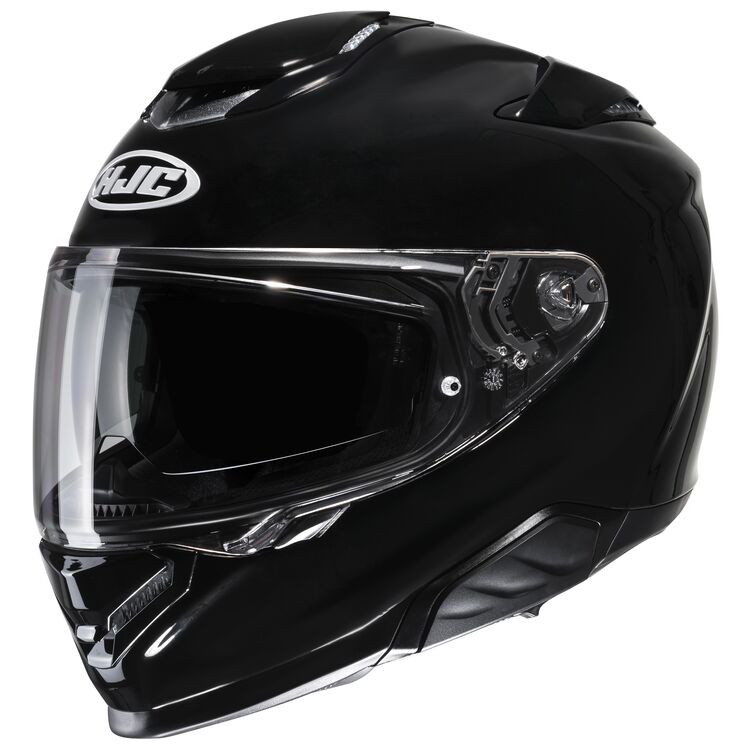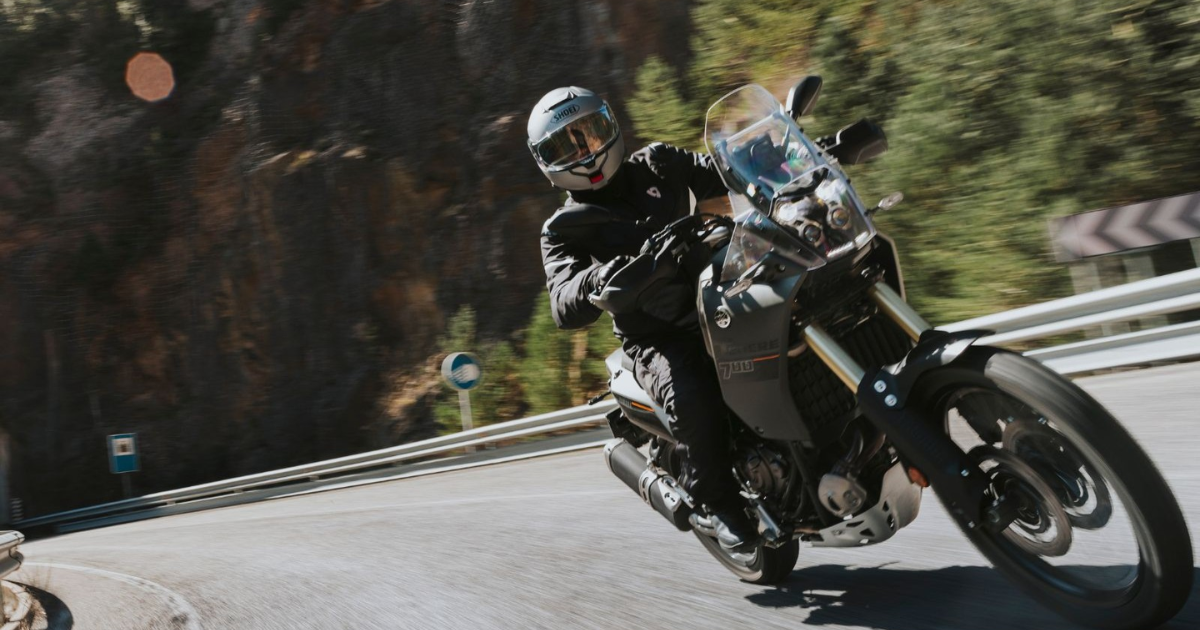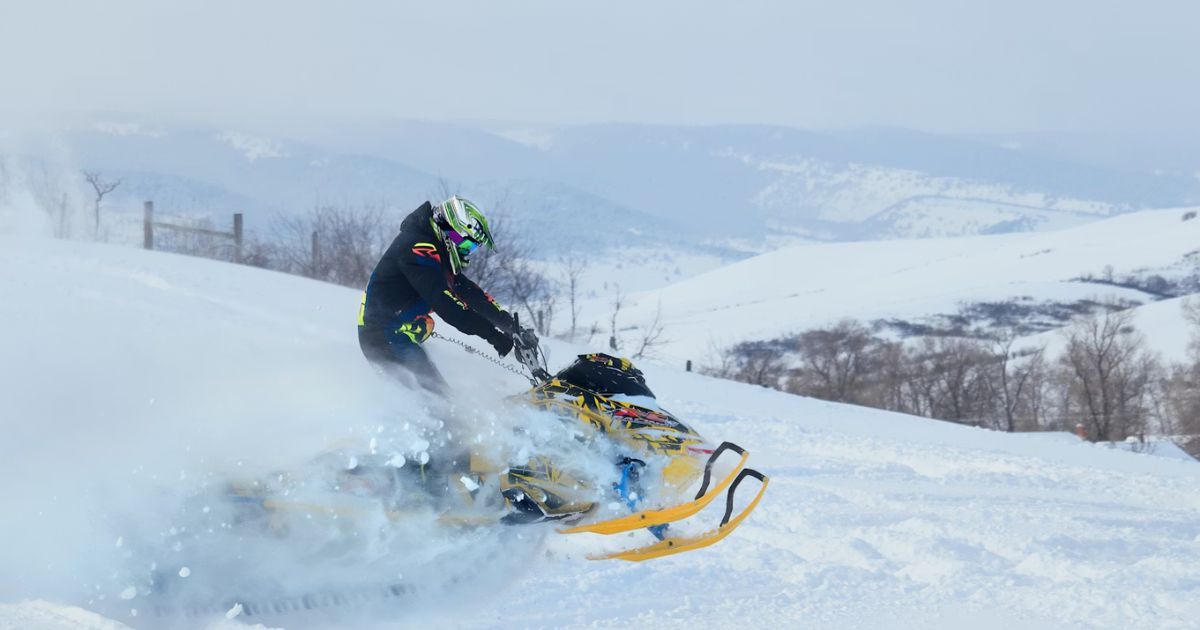
Shoei RF-1400 vs GT-Air 3: Which Helmet for Sport & Commutes?
left for contents
When riders face a choice between the Shoei RF‑1400 and the Shoei GT‑Air 3, they’re really deciding what matters most: lightweight, track‑grade performance versus feature‑rich touring comfort.
Our Testing
We’ve extensively reviewed both of these helmets:
- Shoei RF-1400: Carl’s 4-year ownership review covering thousands of miles from city streets to highway speeds
- Shoei GT-Air 3: Our detailed hands-on review examining aerodynamics, comfort, and touring features
The recommendations below are based on real riding experience with both helmets, not just spec sheets.
Here’s a quick comparison of both, followed by more details on each and what you gain by paying extra for the GT‑Air 3:
Lightweight, Snell‑certified helmet combining advanced aerodynamics, excellent ventilation and a whisper‑quiet ride for sport‑touring and everyday riding. Long term review here. | Touring‑focused helmet with an integrated sun visor and comms‑ready design, delivering a quiet, stable ride and all‑day comfort for long road trips. |
|
|
|
|
Lightweight, Snell‑certified helmet combining advanced aerodynamics, excellent ventilation and a whisper‑quiet ride for sport‑touring and everyday riding. Long term review here.
- Staff pick at Revzilla
- Quietest helmet on the market
- Excellent build quality
- Thick noise-sealing cheekpads
- Visor seal built like Fort Knox
- Snell certified for track use
- Lacks drop down sun shield
- Lacks comms integration slots like GT-Air 3
Touring‑focused helmet with an integrated sun visor and comms‑ready design, delivering a quiet, stable ride and all‑day comfort for long road trips.
- Built‑in sun visor
- Ready for integrated comms
- Quiet ride and stable aero
- Plush liner for all‑day comfort
- Lots of vent adjustability
- Heavier than RF‑1400
- Ratchet strap may irritate throat
Who should buy Shoei RF‑1400:
- Want a lightweight helmet with Snell certification (critical if you ride on a track that requires Snell – almost all tracks in the USA do!)
- Value maximum quiet and aerodynamic stability
- Don’t need an internal sun visor or built‑in comms
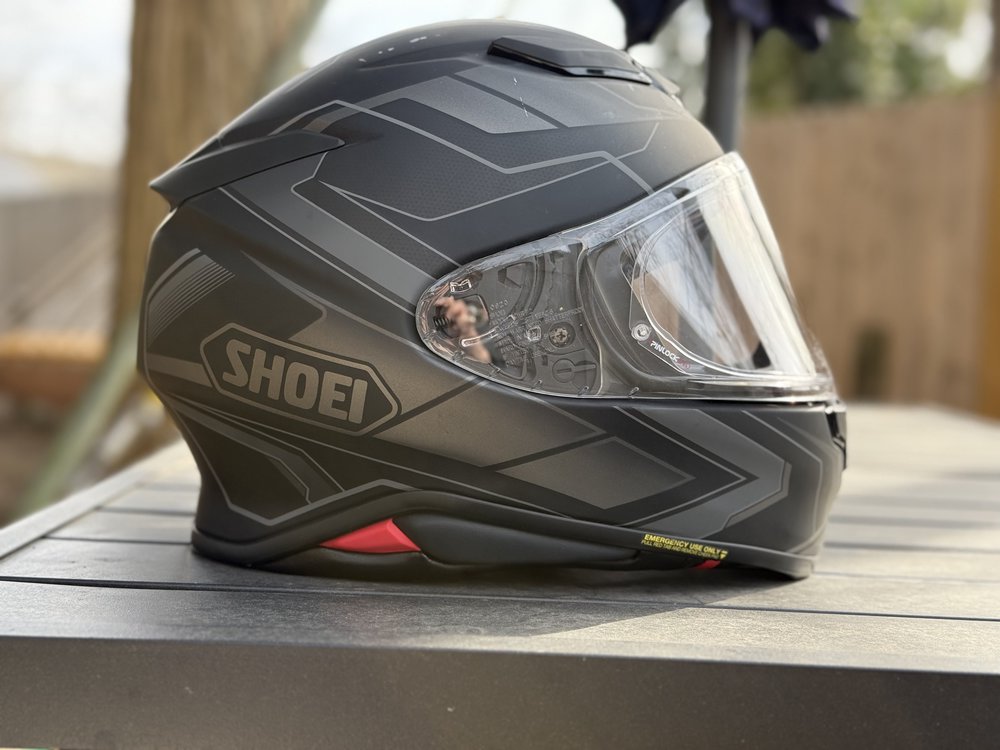
One of the top motorcycle helmets for street riding due to its incredible safety ratings, solid build construction, versatile shell for street and track riding, and reasonable price. Long term review here.
- Staff pick at Revzilla
- Quietest helmet on the market
- Excellent build quality
- Thick noise-sealing cheekpads
- Visor seal built like Fort Knox
- Snell certified for track use
- Lacking touring comfort features like drop down sun shield
Who should buy Shoei GT‑Air 3:
- Prefer a touring‑ready helmet with a drop‑down sun visor
- Want built‑in recesses for a comms system
- Are happy to trade extra weight for added convenience
A premium touring helmet built to disappear on long rides: plush liner, adjustable vents, thick neck-roll and tight sealing visor for that sweet sweet silence and an optically-clear drop down sun shield. Fits the SRL3 Sena comms system seamlessly.
We’ve tested the GT-Air 3 extensively on both touring and sport bikes. Read our full GT-Air 3 review here to see how it performs in different conditions.

The GT‑Air 3 is worth +$100 if you care most about having an integrated sun visor and communications‑ready design. It may feel a bit less constricting than the RF-1400 as well, making it more comfortable for long days of touring. But that’s a personal fit and feel thing!
A premium touring helmet built to disappear on long rides: plush liner, adjustable vents, thick neck-roll and tight sealing visor for that sweet sweet silence and an optically-clear drop down sun shield. Fits the SRL3 Sena comms system seamlessly.
- Super quiet
- Wind tunnel molded for smoother ride (less fatigue)
- Eyeglass compatible
- Internal sun shade and Pinlock visor
- A bit heavier than carbon‑shell alternatives
- Ratchet strap may irritate throat
Now that you’ve got the quick verdict, let’s dig in and break down the specs, what riders are saying, and what you actually get for your money—so you can pick the helmet that’s going to be the best fit for you.
Specs & Pricing Snapshot
To make your decision easier, the table below summarizes weight, materials, safety ratings, features and typical street prices for both helmets so you can compare them at a glance.
| Specs | Shoei RF‑1400 | Shoei GT‑Air 3 |
|---|---|---|
| Weight | ~3.64 lb (medium size) – Shoei’s lightest Snell‑approved full‑face helmet independent tests put a size M at ~3 lb 10 oz | 3.91 lb in size L; measured at 3 lb 14.5 oz without SRL‑3 comms system ~4.05 lb with SRL‑3 installed |
| Fit/Shape | Intermediate‑oval fit with five shell sizes for precise sizing; snug cheek pads reduce noise | Intermediate‑oval fit; three shell sizes; slightly more front‑heavy balance |
| Shell/Materials | AIM+ Multi‑Ply Matrix shell combining fiberglass and organic fibers; dual‑density EPS liner. | AIM fiberglass/organic fiber shell; dual‑density EPS liner |
| Safety/Certifications | Snell M2020D and DOT certifications. European version (NXR 2) is ECE 22‑06 rated. | DOT certification in U.S. and ECE 22‑06 in Europe. |
| Ventilation/Weatherproofing | Redesigned forehead vent with additional intake; enlarged rear exhaust yields stronger negative‑pressure suction. Vortex generators and airtight window beading reduce wind noise. | “Defogger” ventilation system with chin vent, two forehead vents and two exhausts; lower vent has a removable insect filter. Aerodynamic tweaks lower drag 6% and lift 11% vs GT‑Air 2. |
| Visor & Sun Shield | CWR‑F2 shield with flat outer surface and centre locking mechanism for even seal; Pinlock‑ready; no internal sun shield (requires sunglasses). | CNS‑1C face shield with centre‑mounted latch; built‑in QSV‑2 sun shield offering 5 mm more coverage than previous model; Pinlock included. |
| Electronics/Comms | No integrated comms pockets; fits most external systems but may require sticky mounts. | Prepared for Sena SRL‑3 intercom with dedicated recesses; optional Comlink harness on some versions; integrated speaker pockets. |
| Chin Strap | Traditional double‑D ring; prevents slip but takes longer to fasten. | Micro‑ratcheting stainless‑steel strap; narrower than GT‑Air 2 yet still irritates some riders’ throats. |
| Warranty | 5 years (common across Shoei full‑face helmets; includes crash replacement) | 5 years |
| Street Price (typical) | $680–760 for solid or graphic variants; some retailers as low as $530 for solids during sales | $750–930 depending on colour: solids around $779.99; graphics about $879.99; limited‑edition MM93 versions ~$929.99; sale pricing starts near $750 |
Which Shoei Helmet Is Right for You?
Choose the Shoei RF‑1400 if…
- Weight and agility matter. At roughly 3.6 lb the RF‑1400 is one of the lightest premium full‑faces on the market. Lighter helmets reduce neck fatigue on long days and feel nimbler when moving your head. If you frequently ride on twisty roads or track days, the weight difference becomes noticeable.
- You prefer a conventional double‑D ring. The RF‑1400 uses the classic double‑D chin‑strap that many racers and safety instructors trust. It eliminates the throat irritation some riders feel from ratcheting straps and provides a consistent fit.
- Quietness is a priority. Shoei’s wind‑tunnel refinement and Vortex generators reduce wind noise; owners consistently note that this helmet is quieter than earlier RF and GT‑Air models. Less noise helps reduce fatigue on long commutes and allows lower volumes when using earphones.
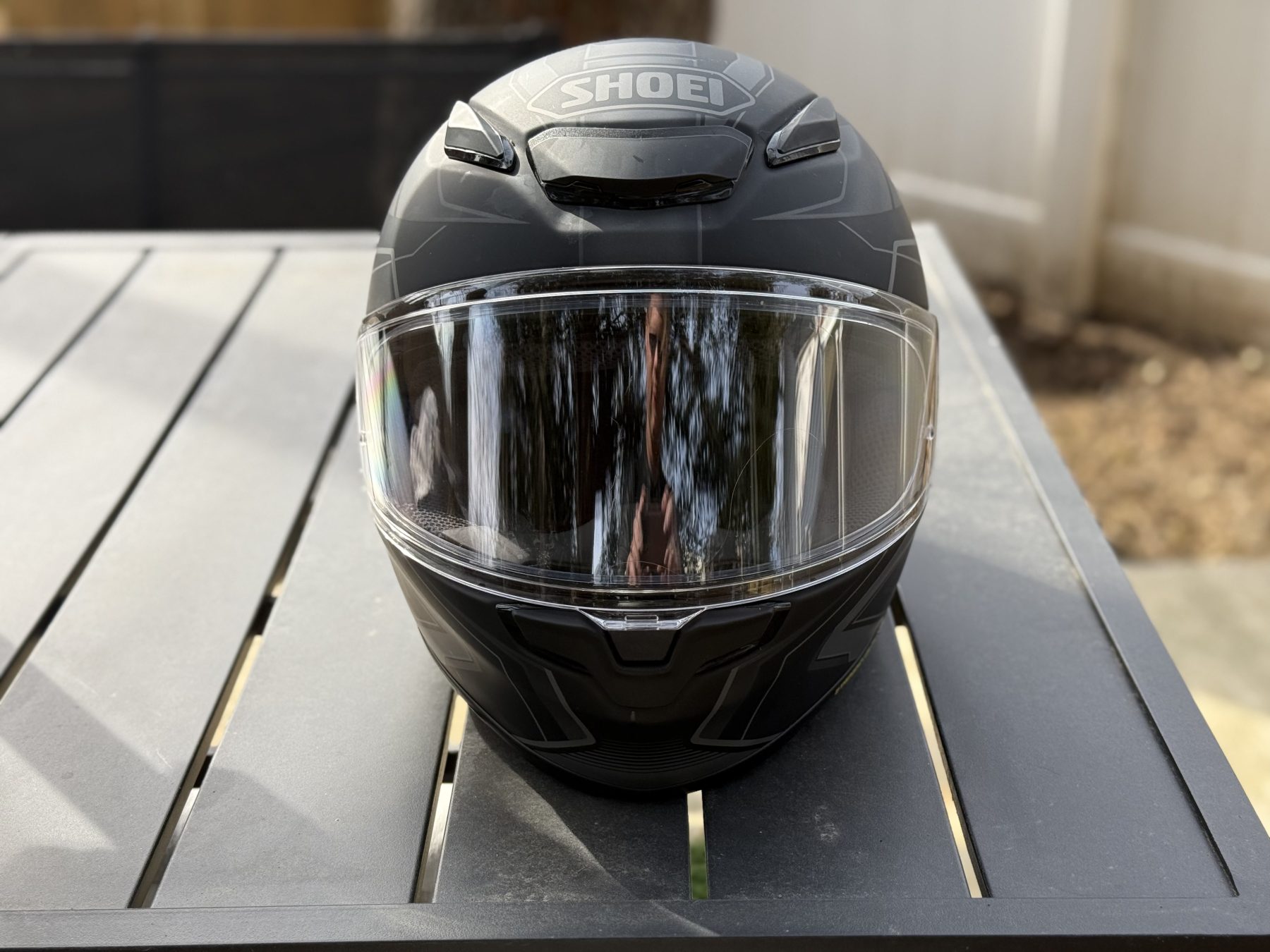
- You want Snell certification. The RF‑1400 meets Snell M2020D standards in addition to DOT, providing extra peace of mind for track use and jurisdictions that require Snell rating.
- You want to save money. A base RF‑1400 costs roughly $100 less than a GT‑Air 3. If you already wear sunglasses or don’t need an internal sun visor, the RF‑1400 offers nearly the same comfort and ventilation for less.
- You prefer fewer moving parts. Without an internal sun visor or ratcheting strap, there are fewer mechanisms to break or malfunction, which some riders prefer for long‑term durability.
Choose the Shoei GT‑Air 3 if…
- You ride long tours or commute year‑round. The GT‑Air 3’s built‑in QSV‑2 sun shield allows quick transitions from bright sunlight to tunnels or night riding without swapping eyewear. Touring riders will appreciate this convenience.
- You plan to add communications. The shell is pre‑engineered for the Sena SRL‑3 and Shoei Comlink systems, with recessed pockets and routing for wiring. This results in a cleaner installation and less wind noise than surface‑mounted units on the RF‑1400.
- You prefer a quick‑release chin strap. The ratcheting stainless‑steel strap is easier to fasten with gloves and to operate quickly at stops. Riders with cold‑weather gear often find it more convenient than a double‑D ring.
- You value touring‑oriented aerodynamics. Shoei claims 6 % less drag and 11 % less lift than the GT‑Air 2. Combined with enlarged side spoilers, this helmet remains stable at highway speeds and in crosswinds.

- You want more ventilation tuning. The GT‑Air 3’s chin vent, two‑stage forehead vent, removable insect filter and improved exhausts offer fine‑tuned airflow control. The built‑in sun visor, however, slightly compromises maximum airflow on hot days.
- You often ride in mixed light conditions or wear glasses. Being able to retract the sun visor means you can wear prescription glasses without juggling sunglasses. The large eye‑port and Pinlock‑ready shield also provide a wide field of view.
From the Saddle: Rider Impressions
Here’s what riders and reviewers have reported after hundreds of miles with each helmet.
Shoei RF‑1400
- Riders praise its whisper‑quiet ride and stability in crosswinds; our four‑year review confirms both its low wind noise and excellent stability.
- Plush interior stays comfortable even on long rides.
- Improved airflow over its predecessor keeps you cooler.
- Lightweight construction reduces neck fatigue on sporty rides.
- Drawbacks include the lack of a built‑in sun visor and reliance on external comms mounts.
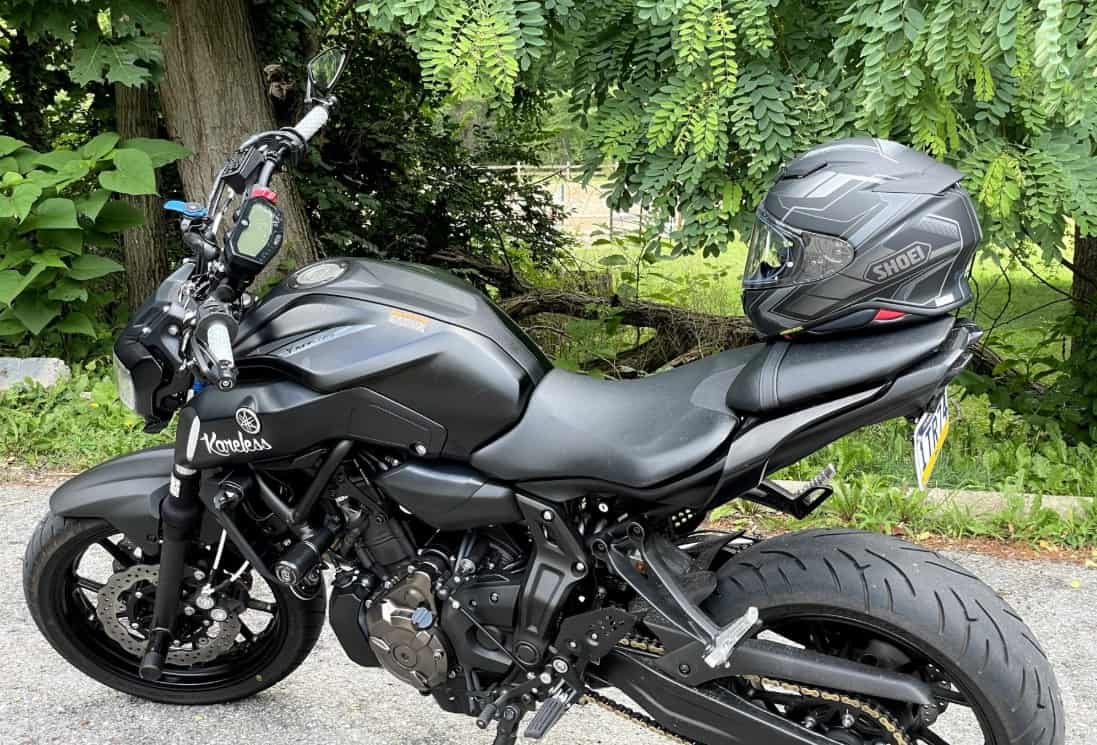
Want to see how it performs after years of use? Check out Carl’s complete RF-1400 review with real-world insights.
Shoei GT‑Air 3
- Owners applaud its premium finish and almost silent ride.
- Slightly front‑heavy yet very stable at speed.
- Built‑in sun shade and easy one‑handed visor operation add convenience.
- Some users find the ratchet strap irritates the throat.
- Integrated comms pockets simplify installation and preserve aerodynamics.

For a deeper look at the GT‑Air 3’s design quirks and performance, see our full review.
Category‑by‑Category Showdown
Noise at Highway Speeds
Both helmets are among the quietest full‑face options.
The RF‑1400’s wind‑tunnel‑shaped shell and Vortex generators create an airtight seal that minimizes turbulence and noise; independent reviewers consistently mention that it’s quieter than its predecessor and many competitors. Carl’s testing at speeds up to 120mph confirms this is genuinely one of the quietest helmets available.
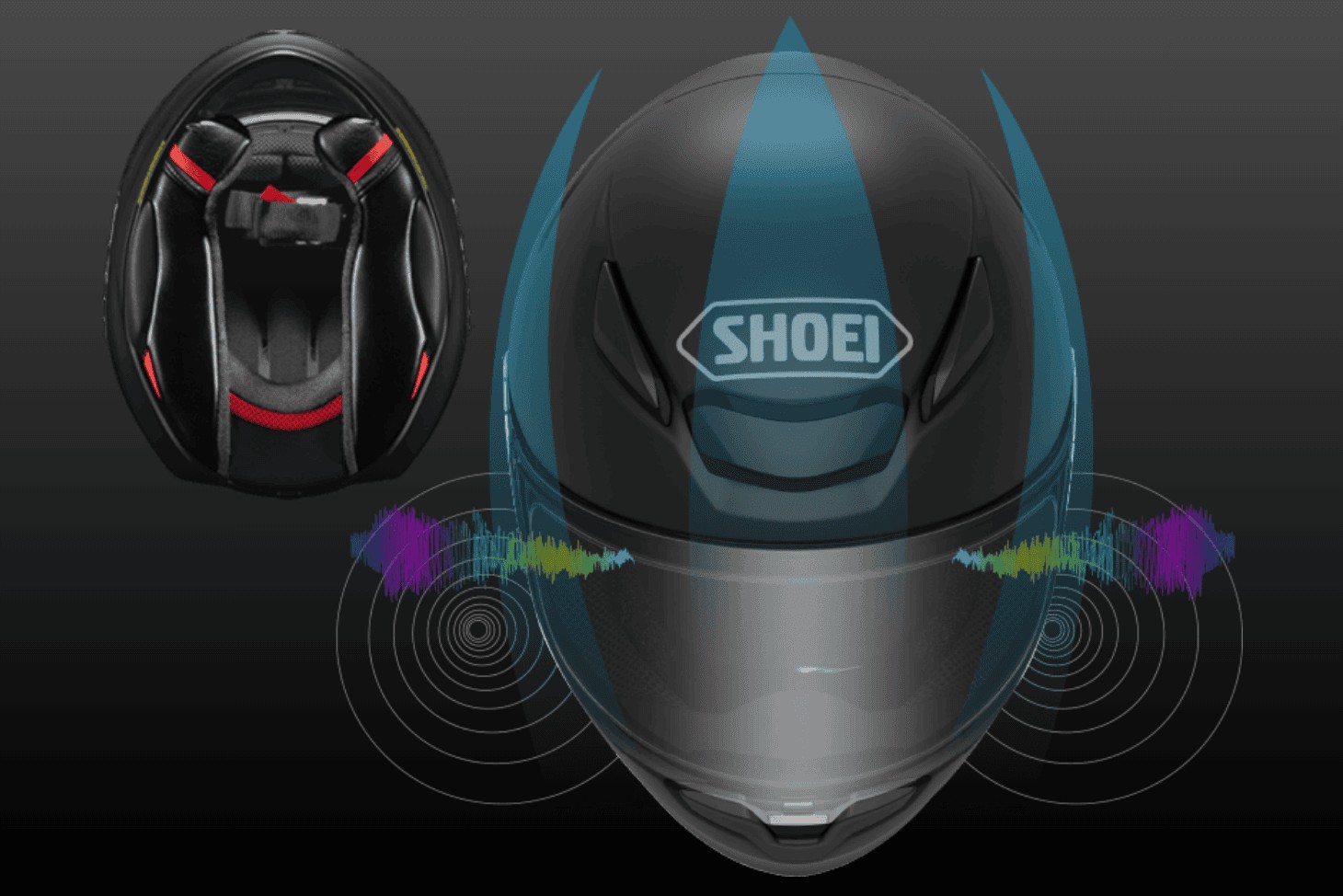
The GT‑Air 3 adds enlarged side spoilers and smoother visor detents, resulting in very low wind noise; some testers feel it is as quiet as the RF‑1400. However, the internal sun visor mechanism and ratcheting strap introduce more potential noise paths, so some riders detect a faint hiss. Our review notes it’s exceptionally quiet for a helmet with this many features. For absolute silence, the RF‑1400 has a slight edge.
Weight & Fatigue
At around 3.6 lb, the RF‑1400 is noticeably lighter. Over long rides, lighter helmets reduce neck strain and are easier to turn quickly when scanning traffic or off‑road obstacles.
The GT‑Air 3’s 3.9‑lb shell adds roughly a quarter‑pound (or more with the SRL‑3 installed). The extra weight is mainly due to the sun‑shield mechanism and integrated comms cavities. Touring riders may not mind the added mass, but sport‑oriented riders will appreciate the RF‑1400’s lightness.
Ventilation in Heat
Both helmets provide solid airflow.
The RF‑1400 uses six intake vents (including a revised forehead vent) and four exhaust ports to move air without generating much noise. Riders note that closing the vents makes the helmet even quieter, while opening them delivers adequate cooling on hot days.
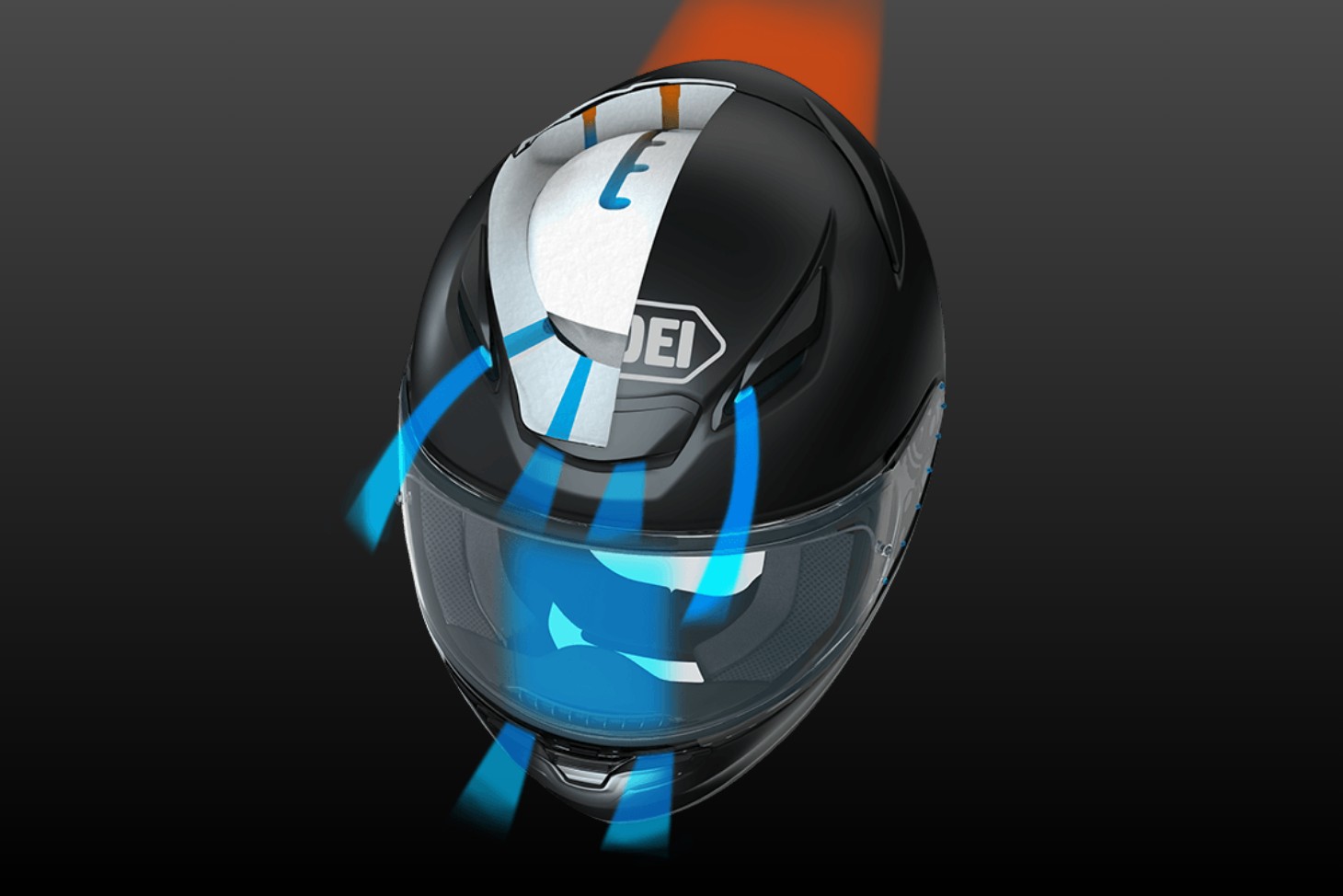
The GT‑Air 3 has a chin vent with an insect filter, a two‑stage forehead vent and two exhaust vents. Shoei claims improved airflow over the GT‑Air 2 and reduced drag. Owner feedback suggests the GT‑Air 3 flows slightly more air at the cost of a bit more noise when everything is open; the built‑in sun visor can obstruct some airflow, making it feel warmer in extreme heat.

Visor & Sun‑Shield Usability
The RF‑1400’s CWR‑F2 shield offers an expansive field of vision and uses a centre locking mechanism that distributes closing force evenly for a tight seal. The visor can be cracked open for defogging, and Pinlock inserts are included. However, the absence of an internal sun visor means riders must carry sunglasses or swap tinted shields.

In contrast, the GT‑Air 3 includes the QSV‑2 drop‑down sun visor, which riders appreciate for convenience. The main CNS‑1C shield has seven detents and a firm centre latch; testers note that locking it requires more effort but offers a rock‑solid closure. The sun shade’s coverage has been increased by 5 mm yet still allows some peripheral light to seep in. Glasses wearers find the GT‑Air 3 more user‑friendly because the drop‑down visor eliminates the need for prescription sunglasses.
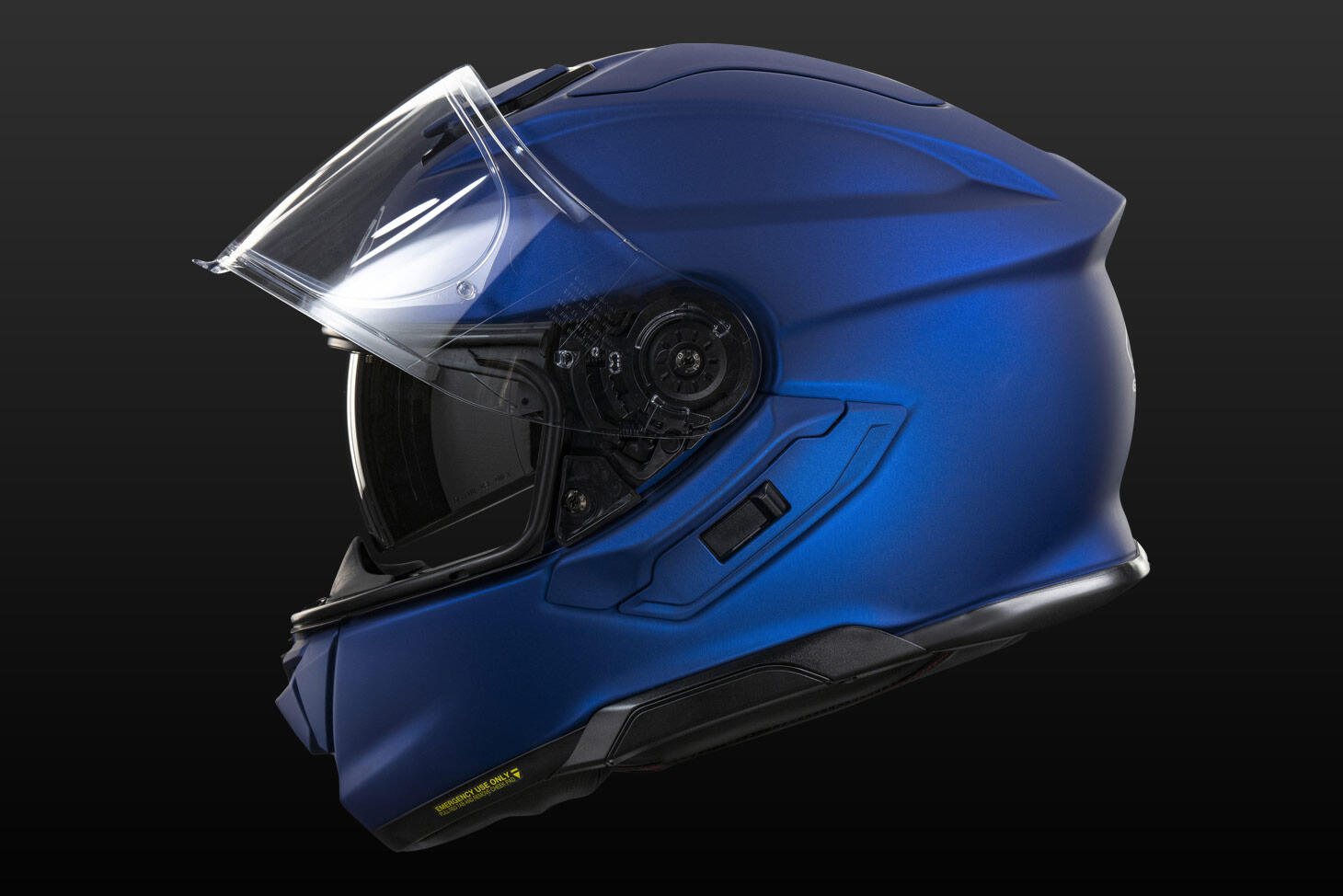
Comms‑Ready Fitment and Electronics
The RF‑1400 doesn’t have integrated comms recesses; riders attach aftermarket units with adhesive mounts or clamps. This works but adds external bulk and potential wind noise.
The GT‑Air 3 is engineered around Shoei’s Comlink platform and the Sena SRL‑3; pockets inside the EPS hold speakers and the battery, and channels run wires cleanly. Riders who plan to use intercoms or music daily will appreciate the tidy installation and minimal wind noise.

For those who ride solo or seldom use comms, the RF‑1400’s simpler shell might be preferable.
Build Quality & Finish
Both helmets share Shoei’s hallmark craftsmanship. The RF‑1400’s AIM+ shell is a multi‑ply matrix with both fiberglass and high‑performance fibres. The interior uses the Max‑Dry II liner and voluminous cheek pads, which are removable and washable. Owners remark that even after years of use, the liner retains its softness and the paint finish remains durable.
The GT‑Air 3’s AIM shell is slightly less sophisticated but still premium; its microsuede liner is plush and moisture‑wicking. The addition of spoiler edges and improved hinge hardware gives the GT‑Air 3 a more aerodynamic silhouette.
Overall, both helmets exude high quality, with the GT‑Air 3 offering more touring‑specific refinements.
Value for Money: Is the Upgrade Worth It?
The price differential between these helmets typically hovers around $100 for similar colorways.
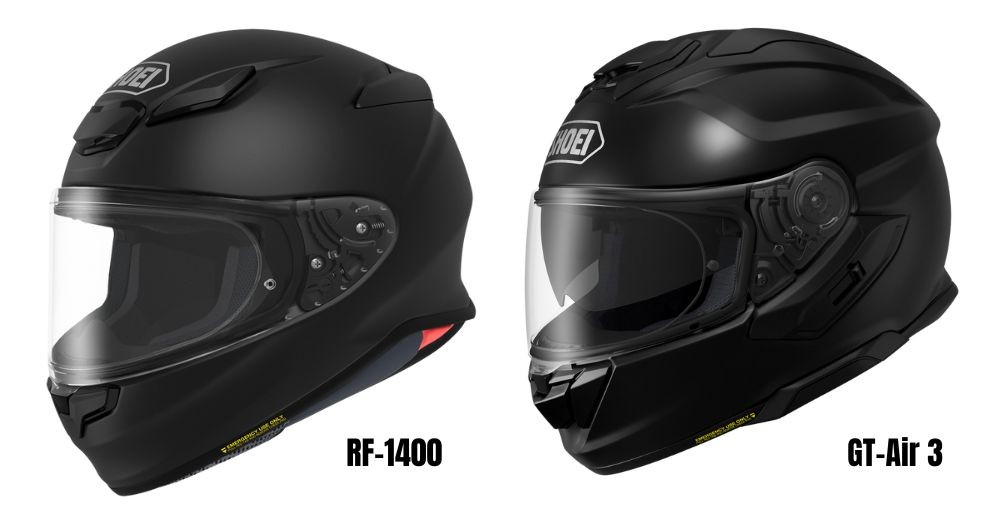
The RF‑1400’s lower price, lighter weight and Snell certification make it an exceptional value for riders who don’t need a built‑in sun visor or integrated comms. In other words, it delivers premium safety and comfort at a mid‑premium price.
The GT‑Air 3 demands a higher outlay because of its touring conveniences. Riders pay for the drop‑down sun visor, micro‑ratcheting chin strap, integrated comms cavities and an aerodynamically refined shell. For long‑distance touring or daily commuting where convenience matters, those features justify the cost.
On the other hand, if you seldom ride at night or don’t plan to use comms, the RF‑1400 offers similar or better performance for less money.
Lightweight, Snell‑certified helmet combining advanced aerodynamics, excellent ventilation and a whisper‑quiet ride for sport‑touring and everyday riding. Long term review here. | Touring‑focused helmet with an integrated sun visor and comms‑ready design, delivering a quiet, stable ride and all‑day comfort for long road trips. |
|
|
|
|
Lightweight, Snell‑certified helmet combining advanced aerodynamics, excellent ventilation and a whisper‑quiet ride for sport‑touring and everyday riding. Long term review here.
- Staff pick at Revzilla
- Quietest helmet on the market
- Excellent build quality
- Thick noise-sealing cheekpads
- Visor seal built like Fort Knox
- Snell certified for track use
- Lacks drop down sun shield
- Lacks comms integration slots like GT-Air 3
Touring‑focused helmet with an integrated sun visor and comms‑ready design, delivering a quiet, stable ride and all‑day comfort for long road trips.
- Built‑in sun visor
- Ready for integrated comms
- Quiet ride and stable aero
- Plush liner for all‑day comfort
- Lots of vent adjustability
- Heavier than RF‑1400
- Ratchet strap may irritate throat
Alternatives Worth a Look
- Shoei Neotec 3 (Modular). If you like the GT‑Air 3’s touring features but prefer a flip‑up chin bar, the Neotec 3 offers similar ventilation and integrated comms with the convenience of going modular. Its weight and price are higher, so it suits touring riders who prioritize comfort and versatility.
A premium modular helmet built for long-distance comfort and low noise, with a smooth flip-up chin bar, tightly-sealing visor and wide drop down sun shade. Fits the SRL3 Sena comms system seamlessly.
- Comfortable wear all day
- Quiet, aerodynamic performance
- Flip-front convenience at stops
- Integrated comms & sun visor
- Faceshield lock is sometimes stiff
- Heavier weight may fatigue neck on long rides
- Arai Signet‑X. A premium full‑face helmet with Snell certification and an intermediate‑oval fit. It lacks an internal sun shield but offers exceptional ventilation and hand‑built quality. It is more expensive but appeals to riders who prefer Arai’s long‑oval fit and unique safety philosophy.
Purpose-built for long‑oval heads, the Arai Signet‑X delivers exceptional comfort, top-tier Snell-rated protection, and robust ventilation—all without pressure points or fit compromises.
- Long-oval: no forehead hotspots
- Lightweight: less fatigue on long rides
- Excellent airflow: stays cool in heat/traffic
- Snell M2020/DOT; adjustable padding
- Vent-heavy design can be noisy
- Face-shield latch is stiff with gloves
- HJC RPHA 71. A mid‑price touring helmet with an integrated sun visor and lightweight PIM+ composite shell. It’s quieter than previous RPHA models and provides good ventilation. It doesn’t have Snell certification but costs less than either Shoei, making it a strong value option.
A lightweight sport-touring helmet combining performance, comfort, and sleek design.
- Aerodynamic shell with excellent stability at high speeds
- Advanced moisture-wicking interior with removable padding
- Integrated sunshield and Pinlock-ready face shield for versatile visibility
- Bluetooth system compatibility requires separate purchase
Frequently Asked Questions
Is the Shoei GT‑Air 3 quieter than the RF‑1400?
Both helmets are very quiet, thanks to Shoei’s wind‑tunnel development. Tests indicate that the RF‑1400’s simpler shell and lack of a sun‑visor mechanism keep noise slightly lower.
The GT‑Air 3 remains extremely quiet but may produce a faint hiss when its vents are wide open.
Can I wear glasses or sunglasses with these helmets?
The RF‑1400 doesn’t have an internal sun shield, so riders typically wear sunglasses or use a tinted shield. The large eye port allows room for eyewear.
The GT‑Air 3 has a built‑in drop‑down sun visor and is designed to accommodate prescription glasses; you may not need separate sunglasses.

Are both helmets ECE 22‑06 certified?
The RF‑1400 sold in the U.S. carries Snell M2020D and DOT certifications. European versions are ECE 22‑06 approved but not Snell.
The GT‑Air 3 is certified to DOT in the U.S. and ECE 22‑06 in Europe.
Does the RF‑1400 accept integrated communication systems like the Sena SRL‑3?
You can fit universal comms systems to the RF‑1400 using adhesive or clamp mounts. However, the helmet lacks built‑in speaker cut‑outs, so you must route wiring under the liner.
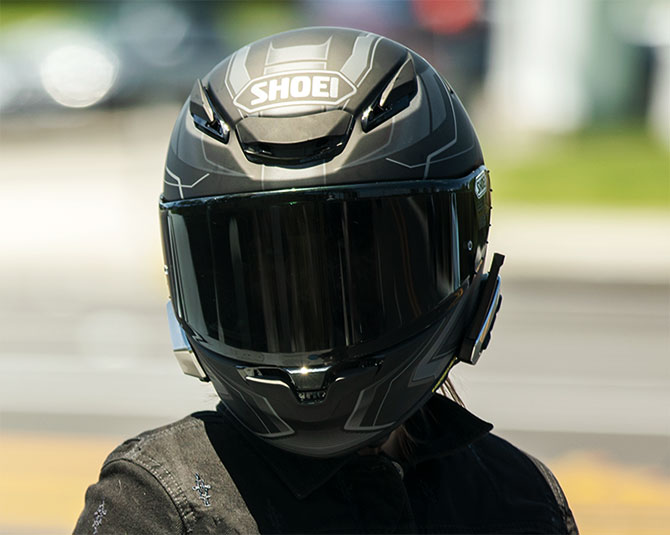
The GT‑Air 3 has dedicated recesses designed specifically for the SRL‑3 and Comlink systems.
Which helmet is better for hot weather?
Both flow a lot of air. The RF‑1400’s six intakes and four exhausts provide strong ventilation without much noise. The GT‑Air 3 has improved vents and a removable insect filter but can feel warmer because of the internal sun‑shield mechanism. Riders in extremely hot climates may prefer the RF‑1400’s simpler airflow.
How long is the warranty and what does it cover?
Shoei offers a 5‑year warranty on both models, covering manufacturing defects and issues with the shell, shield and interior components. The warranty does not cover crash damage, though Shoei may offer discounted crash replacement.
Not sure your comms unit will fit?
Sometimes the perfect helmet comes with a catch—it’s designed around a specific Bluetooth unit. That can make it tough if you prefer something different. With an adapter from Tubs Jackson, you can get a factory fit for any comms units on helmets you actually want to ride in.
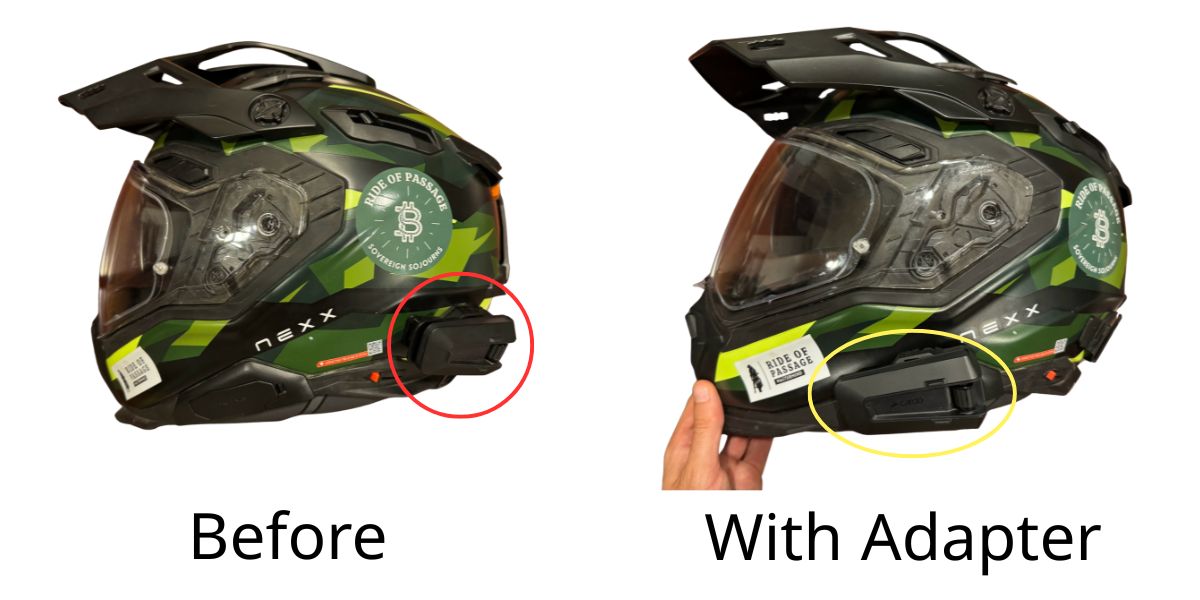
Tubs Jackson is a weird name, I know, but I have their adapter in my Nexx X.WED3 helmet and it’s rock solid. Much nicer than reaching way back to where I had the sticky mount before. I wish I’d thought of this idea.
Tip: Get FREE SHIPPING just by buying here or using code BETTERONTHEROAD at checkout.
Related

Carbon Fiber Modular Helmets: Ultimate Flip-Up Lids
Discover carbon fiber modular helmets that deliver flip-up convenience, lightweight strength, and serious protection for every ride.





